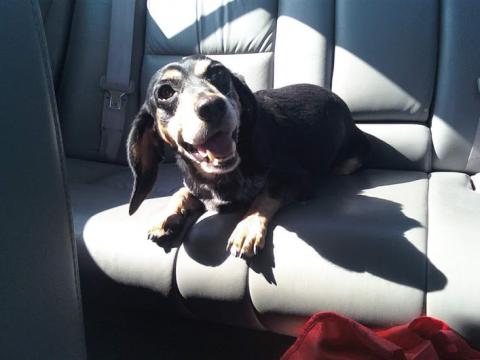Road-tripping with your pet: 11 travel tips to keep them safe

- Under no circumstances should you allow your pet to drive. This one's non-negotiable.
- You're supposed to keep your dog or cat or whatever in a well-ventilated crate or carrier. I have always been very bad at this, but I have cats, so I feel like in this instance you're just doing whatever you can to survive. But you're really supposed to keep them in carriers. Make sure it's large enough for your pet to stand, sit, lie down, and turn around in. It's a good idea to let your pet get used to the crate in your home. Keep the crate or carrier in the back seat, secured with a seat belt.

- Get your pet geared up for a long trip by taking him on a series of short drives first, gradually lengthening time spent in the car. And please be sure to always secure the crate so it won't slide or shift in the event of a quick stop. Or, if you're like me, when you bring a new kitten home, occasionally allow it to crawl all over your shoulders and neck while going for drives. This allows your cat to be OK with riding in cars in the event that you absolutely must take them in the car. This is also terrible advice. Please don't take it! Use the good advice that involves a crate, or plan for your animal to never leave the house.
- Feed your pet three to four hours prior to departure. Don't feed them in a moving vehicle. If you have left some chocolate bars in your car, and your dog is an idiot and eats them, have some peroxide on hand to induce vomiting. Now we're road-tripping, am I right?!
- Never leave your animal alone in a parked vehicle, EVER. This is literally ALWAYS bad. On a hot day, even with the windows open, a parked automobile can become a furnace in no time, and heatstroke can develop. In cold weather, a car can act as a refrigerator, holding in the cold and causing the animal to freeze to death. More info on dogs in hot cars in available here.
- Have a travel kit for your animal. The kit should include travel papers, food, bowl, leash, a waste scoop, plastic bags, grooming supplies, medication and a pet first-aid kit. Bring some sort of security blankie or toy, too, especially if you're traveling with a dog. If you're an irresponsible cat owner like me, just be happy when they stop yowling in distress and start sunning themselves in the back window. (Don't actually do this! Put them in a crate!)

- As per always, your pet should have an UP-TO-DATE(!) microchip for identification and wear a collar with a tag imprinted with your home address. While you're traveling, attach an additional tag with your cell phone, destination phone number, and any other relevant contact information.
- This is going to sound like the ultimate cruelty, but don't let your dog ride with his head outside the window, no matter how happy and majestic he looks with his lips flapping and drool flying out of his mouth. He could be injured by flying objects or bees.
- If you're travelling across state lines, bring along your pet's rabies vaccination record, as some states requires this proof at certain interstate crossings.
- Bring bottled water or tap water stored in plastic jugs rather than using local tap water, since drinking water from an unfamiliar area could result in tummy upset for your pet
- If you travel frequently with your pet, or if she is a dog who insists on eating chocolate bars in your car, you may want to invest in rubberized floor liners and waterproof seat covers. A cheaper, more-humiliating option is dog diapers.

Information from ASPCA
And if you happen to be a professional trucker and want to take your best buddy on the road with you, here are some tips for safe traveling with your pet in a commercial truck.

Add new comment